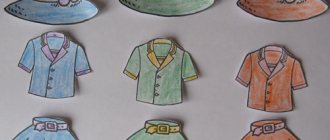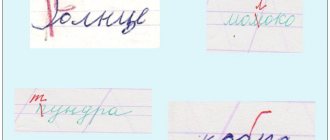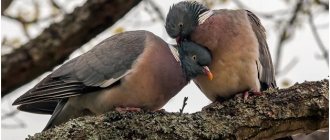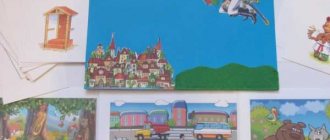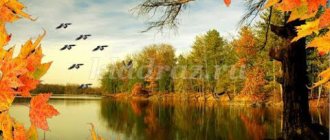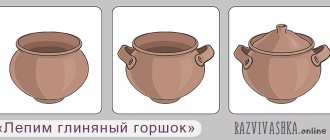Didactic games for older preschoolers 5-7 years old. Topic: Wintering birds
Didactic games for children of the senior preparatory group of kindergarten on the topic “Wintering birds”
Author: Pavlova Vera Valerievna, teacher of the special group of the Municipal Educational Institution "Bendery Kindergarten No. 9", Bendery Abstract: I offer a variety of didactic games and exercises for the formation of cognitive interest and speech activity, attention and logical thinking on the lexical topic "Wintering Birds", which are intended for educators and parents. Purpose: the proposed material will be useful in the implementation of educational activities, in joint and independent children's activities. Age audience: children of senior preschool age (5-7 years) Goal: formation of cognitive and speech activity of children by including a variety of games and exercises on the topic “Wintering birds” Objectives: - clarify and systematize children’s knowledge about wintering birds of the region (Moldova); -expand your vocabulary by forming complex words and consolidate the agreement of nouns with numerals; -develop memory and thinking, develop the ability to give reasons for your answers; - consolidate knowledge of proverbs and sayings about wintering birds. Didactic game “Guess what kind of bird, according to words and descriptions” Purpose: to consolidate the characteristics of wintering birds, to develop the ability to form complex words (red-breasted, long-tailed, etc.). Progress of the game: The teacher helps the children look at pictures of birds and says that he will name four words that suit this wintering bird.
Pupils listen carefully to the words and show a picture of a wintering bird. Then one child explains the answer. If the answer is correct, you can reward the child with a chip. Second version of the game: when consolidating the material, you can invite the children themselves to be the presenters and make wishes for wintering birds one by one. Didactic game “Recognize a bird by body parts” Goal: recognizing the external appearance of wintering birds of the region and developing speech skills to justify your answer. Progress of the game: The teacher shows the children a picture of nine birds, which are partially hidden under snowflakes.
Children guess the birds and explain their answers. If you give a correct, reasoned answer, you can reward your child with a chip. Explanations for teachers: In Moldova, wintering birds include: mute swan; nuthatch; sparrow; Great Grebe; hawk; magpie; gray and white heron; tit; mallard ducks; bullfinch and others. Didactic game “Lay out wintering birds according to the pattern” Goal: correlating wintering birds and geometric shapes, laying out a chain of four birds using modeling technology Progress of the game: The teacher shows large cards on which wintering birds are depicted and symbols under them - geometric shapes of different colors.
Children have small cards with images of wintering birds (6 pieces).
Each child has one long card with geometric shapes.
Children, under these figures, lay out the birds that these figures represent according to the model. Option two: when fixing the material, the birds and shapes can be changed and the number of geometric shapes can be increased to 6 (if the children can handle it). Option three: you can have a conversation: 1. Which bird is your first? Third? Fifth? 2. Swap the third and fifth birds with each other. Which bird is now third? Etc. Explanations for teachers: in the presented game, wintering birds from the region of Moldova were selected, and teachers from other regions and countries can easily replace these birds with birds from their region. Didactic game “Count the birds” Goal: recognizing wintering birds by their external and distinctive features and matching nouns with numerals. Progress of the game: Teacher: Guys, there is a feeder in front of us and birds have flown to it. What kind of birds are these, help me guess? Children explain their answers. Now let's count how many birds flew to the feeder? Why do you think so? (For example, I saw three titmouse tails, which means there are three titmouses) If the answer is correct and reasoned, you can reward the child with a chip.
Didactic game “Be careful!” Goal: summarizing information about wintering birds (appearance, habitat, nutrition, care of offspring, characteristic features, etc.) Progress of the game: Each child is given a card with a picture of nine wintering birds of the region and chips.
The teacher explains that for each wintering bird you can choose words that will help you talk about it. Children listen carefully to the word describing a wintering bird and use counters to cover one or another bird. Then they explain their choice. If the answer is correct and reasoned, you can reward the child with a chip. Cheat sheet for teachers: Vocabulary: small, lively, forest, gray, flying, dexterous, red-breasted, swims, agile, urban, jumping, cheerful, swamp, chirps, brave, omnivorous, smart, hollow, big, lively, long-tailed, cheerful, dragonfly, predatory, snow-white, white-sided, long-legged, small, agile, diving, hunting, wintering, waterfowl. Didactic game: “Collect a proverb” Purpose: to consolidate proverbs and sayings about wintering birds and explain the meaning of proverbs. Progress of the game: The teacher explains that parts of proverbs and sayings are mixed up, we need to help correctly restore the beginning to the end. If children do not yet have reading skills, then the teacher himself reads (children of the older group). Option one: the teacher reads the beginning, the children finish the proverb. Option two: the children read the end of the proverb, remember the beginning. Option three: children alternately read the beginning of the proverb, then the end. Proverbs and sayings about wintering birds: The magpie knows where to spend the winter. A woodpecker does not peck at a healthy tree. No matter how much a raven croaks, it will never be a nightingale. Birds have strong wings, and people have friendship. A young sparrow learns to tweet from an old one. The bird is red in plumage, and man is in skill. The titmouse is a small bird, and it remembers its holiday. Every bird flies to its flock. The word is not a sparrow; if it flies out, you won’t catch it. Each bird feeds with its own nose. The tit is a bird across the sea. Where the crow did not fly, but fell into the claws of a hawk.
Didactic game: “Guess the rebus - find out what kind of bird it is” Goal: developing skills for the ability to guess words - rebuses, using knowledge of prepositions. Progress of the game: The teacher offers children pictures with encrypted words - puzzles. Children need to guess the words and explain their answer.
Cheat sheet for teachers: Answers to puzzles: bullfinch, crow, sparrow, magpie. Didactic game “Help the Sparrow” Goal: to develop skills in passing labyrinths. Progress of the game: The teacher offers to help the sparrow get to the feeder by walking through the maze. Children complete the task independently.
Have fun playing with your students!
Presentation on the topic: Didactic games “Wintering Birds”
We recommend watching:
Summary of educational activities on cognitive development in the middle group. Friends for a sparrow Summary of OD on familiarization with the outside world in the middle group. Wintering birds Summary of a lesson on familiarization with the environment (preparatory group for school). Topic: Wintering birds Didactic games for older preschoolers 5-7 years old. Theme: Winter
Similar articles:
Winter games for older children in kindergarten
Thematic lesson: Wintering birds
Winter is still coming and the birds need our help. This is a good time to play with the children and teach them more about birds. Previously, there were Sudoku, Lacing and Clothespins materials. I have prepared for you tasks on the topic “Wintering Birds” to develop logic, fine motor skills, the ability to write, read and count, as well as draw and much more! This is a completely ready-made material for conducting a lesson on this topic with methodological recommendations for each type of task. I bring to your attention tasks for children from 1.5 to 6 years old on the topic “Wintering birds”. Types of tasks for a thematic lesson:
- Lay out the letters S, D, G, V and birds with pebbles
- Quantity cards for games with clothespins
- Memory cards for the development of logic and memory
- Game "Find the bird from the fragment."
- Cards for playing with clothespins - find the same one
- Fold the halves for kids
- Solve puzzles for older children
- Labyrinth "Bird Tracks"
- Trace according to the pattern given at the beginning of the page.
- Sort birds by size and type
- Arrange the birds by size
- Bird structure - learning to read
- Puzzles with numbers from 1 to 5, from 1 to 10, from 11 to 20.
- Write down the words - the names of all wintering birds
- Color the birds in the indicated colors
- Wires
- Connect in order from 1 to 10 and from 11 to 20
- Connectors
- Find the superfluous - develop logic
- Walk the lines
- Math puzzles
- Connect by numbers from 1 to 45
- Draw a woodpecker in cells
- Find five differences
- Read and match the picture and description
- Write the alphabet
- Learning to write letters
- I'm learning to write words
- Write the numbers
- Count the examples
- We collect and count
- Fill in the missing numbers
- Complete the sentences
- Continue logical series
- Math maze up to 20
- Follow the tracks with your fingers
- Walk your finger over the bird
- Game "Wintering Birds"
- Connect the syllables - read and remember
- Cut out a feather
- Fill in what's missing
- Creative tasks
- Description of the bird according to plan
- Physical exercises “Tit”, “Sparrows”
- Finger gymnastics “The birds flew up to the house”
- Pure talk
- List of recommended books to read
PS This article is copyrighted and is entirely intended exclusively for private use; publication and use of it on other sites or forums is possible only with my written consent. Use for commercial purposes is strictly prohibited. All rights reserved. Author: Leonova Evgenia.
I really want to appeal to everyone who loves to analyze my tasks into pictures and post them on various social networks and on their websites. Let's respect each other's work! I specially make every picture and task MYSELF ! I spend a lot of time and effort on this! If I offer you these materials for free , this does NOT mean that you have the right to post them under your own names and in other formats! If you want to talk about them, then use my picture and make an active link to this page of the site. Due to the current circumstances, I would like to warn you that if I still find my materials in disassembled form on the Internet, then I will make all thematic classes PAID.
I apologize for the mistake, I corrected it and re-uploaded “The Structure of Birds”. But you can fix it yourself by covering up these letters)))
You might be interested in:
Thematic lesson: Fifth day of creation part 2
Count the animals
Marine mathematics
Playing with a child, studying wintering birds
November is the best time to introduce your child to wintering birds. After all, most of them can be seen in the city. Tell your child that birds need human help in winter. Together, make feeders for them.
With the themed set “Wintering Birds” you can spend a themed week. By studying for just 15 minutes daily, you will develop your child’s memory, attention, speech, and logic. And establish an emotional connection with him. I noticed that when my child and I play themed weeks, he is calmer.
With the themed set “Wintering Birds” you can play with children from 3 to 7 years old. Some activities can be made more difficult or easier depending on the age of the child.
The themed set “Wintering Birds” consists of 22 pages with games and tasks for children:
1. Cards with the names of birds
Print out the cards in 2 copies. Play lotto with the kids, name the bird, the child finds it on a large card and puts a small one on it.
You can play memory with older children.
And for those kids who are learning to read, we cut off the names of the birds, mix them up and match the name to the picture.
2. Memory grid
We remember the location of the birds on the card. Let's turn it over. And we arrange the birds in the grid in the correct order. Let's check. To begin with, take a 4-square grid. Then a more difficult level, a 6 square grid.
3. Sudoku
Here you need to place the birds in a grid so that in each row and in each column there are birds of a different species.
4. Graphic tracks
Draw your finger or pen along the lines. We correctly name the birds that are located in circles. Name the colors that are also located in circles
5. Logic games, who is bigger, who is heavier
With the kids we determine which nest this or that bird is sitting in. Depending on its size.
6. Puzzle
With the kids we assemble a puzzle of 2, 3, 4 halves
Older children will have a more difficult time
7. Plasticine applications
We find plasticine of the desired color, if it is not available, we mix the colors.
We stick patches on white circles
8. Game to develop intuition
We hide the bird behind a large or small nest. We ask the child to guess where the bird is hiding. A more difficult level is to guess which bird is hiding.
9. Identify the bird by its outline
10. Stencils
We laminate the stencils and cut them out with scissors. With the kids we paint the stencil with paints. With older children we outline the outline and ask them to shade
11. Game “Place the birds on the branches”
Fold the double cards in half. Pull the string or thread. We ask the child to put the birds on the branches. This game perfectly develops fine motor skills and is very popular with children.
12. Shadow game
We identify birds by the shadow in the picture. You can make a game with Velcro.
13. Fragments
Find a fragment of the picture and glue it in place
14. Who hid in the lump
We crumple the cards with birds into lumps. The child must straighten the picture and name the bird correctly
15. Counting birds
And choose the correct answer.
You can mark with a pencil or marbles, as in the photo. Or make cards and attach clothespins. You can purchase a themed set in the store
